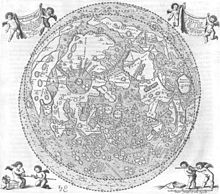This is an old revision of this page, as edited by 91.10.195.80 (talk) at 09:09, 3 April 2007 (mistake removed). The present address (URL) is a permanent link to this revision, which may differ significantly from the current revision.
Revision as of 09:09, 3 April 2007 by 91.10.195.80 (talk) (mistake removed)(diff) ← Previous revision | Latest revision (diff) | Newer revision → (diff)Johannes Hevelius (Latin), also called Johann Hewelke, Johannes Höwelcke or Johannes Hewel (in German), or Jan Heweliusz (in Polish), (born January 28 1611 – died January 28 1687), was a councilor and mayor in Danzig (now Gdańsk). As an astronomer he gained the reputation of "the founder of lunar topography".

Hevelius father was Abraham Hewelke (1576-1649), his mother Kordula Hecker (1576-1655). It was a family of wealthy brewing merchants of Bohemian origins. After Gymnasium where he was taught by Peter Crüger, Hevelius studied jurisprudence at Leiden in 1630, then traveled in England and France, meeting Pierre Gassendi, Marin Mersenne and Athanasius Kircher. In 1634, he settled in his native town, and on March 21 1635, he married Katharine Rebeschke, a neighbor who was two years younger, owning two adjacent houses. The following year, Hevelius became a member of the beer brewing guild which he led from 1643 onwards.

Throughout his life, he took a leading part in municipal administration, becoming Ratsherr (town councillor) in 1651 and later mayor of Danzig, but from 1639 onwards, his chief interest became centered in astronomy. In 1641, he built an observatory on the roofs of his three connected houses, providing it with a splendid instrumental outfit, including ultimately a tubeless telescope of 45 m (150 ft.) focal length, constructed by himself.
This private observatory was visited by Polish Queen Maria Gonzaga on 29 January 1660, and in 1678 by Polish King John III Sobieski. A young Edmund Halley, emissary of the Royal Society of which Hevelius was a member since 1664, visited him in May 1679.
Hevelius made observations of sunspots, 1642–1645, devoted four years to charting the lunar surface, discovered the Moon's libration in longitude, and published his results in Selenographia sive Lunae Descriptio (1647), a work which entitles him to be called the founder of lunar topography.
Four comets were discovered by him, in the years (1652, 1661 (probably the same as Ikeya-Zhang), 1672 and 1677. These discoveries led to his thesis of the revolution of such bodies in parabolic tracks round the sun.
Katharine, his first wife, died in 1662, and a year later Hevelius married Elisabeth Koopmann, the young daughter of a merchant family. The couple had four children. Elisabeth supported him, published two of his works after his death, and is considered the first female astronomer.
His observatory, instruments and books were maliciously destroyed by fire on September 26 1679. The catastrophe is described in the preface to his Annus climactericus (1685). He promptly repaired the damage, so far as to enable him to observe the great comet of December 1680. He invented the constellation of Sextans in memory of these lost instruments. His health had suffered from the shock, and he died on his 76th anniversary, on 28 January 1687.
In late 1683, as commemoration of the victory of the Christian forces led by King John III Sobieski in the battle of Vienna, he invented and named the constellation of Scutum Sobiescianum (shield of Sobieski), now called Scutum.
Hevelius had his book printed in his own house, at lavish expense, and himself engraved many of the printing plates.
Works
- Historiola Mirae (1662), in which he named the periodic variable star Omicron Ceti "Mira", or "the Wonderful"
- Prodromus cometicus (1665)
- Cometographia (1668)
- Machina coelestis (first part, 1673), containing a description of his instruments; the second part (1679) is extremely rare, nearly the whole issue having perished in the conflagration of 1679
- Annus climactericus (1685), describes the fire of 1679, and includes observations made by Hevelius on the variable star Mira
- Prodromus astronomiae (1690), his posthumously published catalog of 1564 stars. Its value was much impaired by his preference of the antique pinnules to telescopic sights on quadrants. This led to an acrimonious controversy with Robert Hooke
- Firmamentum Sobiescianum (1690), an atlas of 56 sheets, corresponding to his catalogue, contains seven new constellations delineated by him which are still in use (plus some now considered obsolete)
See also
External links
- Galileo Project on Hevelius
- Electronic facsimile-editions of the rare book collection at the Vienna Insitute of Astronomy
- Template:Pl icon Jan Heweliusz - Gdańszczanin Tysiąclecia
| Constellations introduced by Johannes Hevelius after 1687 | |
|---|---|
| IAU-recognized constellations | |
| Obsolete constellations (non-IAU constellations) | |